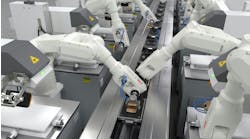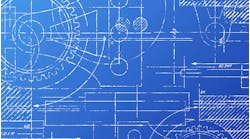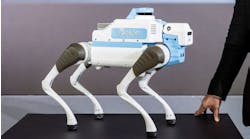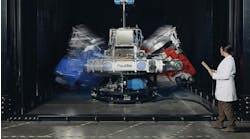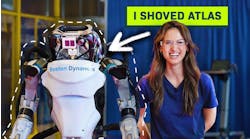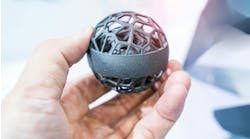AI is likely to be a major game changer for the global economy and is expected to create a total economic impact of $15.7 trillion by 2030. With the potential associated with AI, recent years have witnessed a phenomenal development of AI-based technology.
The manufacturing sector, which is an integral part of the world economy, is also making great strides in the implementation of AI-based technology. All these tech solutions are aimed at self-learning, adaptability, and the autonomy of manufacturing systems.
Applying AI Technology
The collection of high-quality and meaningful data, along with its analysis, is the core of AI-based systems. A Harvard Business Review report suggests that most AI use cases in manufacturing will occur primarily in two areas: supply chain management and predictive maintenance.
These two areas broadly constitute Enterprise Asset Management (EAM). The comprehensive software packages allow a seamless transition from traditional manufacturing practices to intricate Enterprise Asset Management.
1. AI-Based Enterprise Asset Management (EAM)
EAM is all about the effective management of assets, regardless of whether these assets are of the same type and one place, or disparate and distributed between multiple locations. The central idea of an EAM is to collect data from manufacturing plants and analyze it through a single platform.
Integrating AI in your EAM enables meaningful analysis of the data, identifying data patterns, and leading to knowledge-based action items. A properly set EAM software paints a holistic picture of your complete enterprise by providing you with in-depth insights into asset performance, asset reliability, asset tracking, and overall facility management.
A good EAM software must be intuitive, have a logical flow, and be user-friendly. JD Machine Corp, a precision machining company, was able to reduce machine downtime by 40% and saw a 30% increase in sales by implementing an EAM software.
2. AI-Based Predictive Maintenance
Maintenance management is another area that has been revolutionized by the introduction of artificial intelligence. Such maintenance management systems continuously collect real-time data using sensors and analyze it through Machine Learning (ML) algorithms. Such analyses enable identifying the data patterns that might result in a machine failure/downtime.
That way the deployment of AI facilitates the development of robust predictive maintenance schedules, consequently lowering downtimes and increasing plant yield.
Siemens, a German industrial automation company is using AI for a dynamic diagnostic of rotors in large compressors and generators. These diagnostic systems help in preventative maintenance and can predict any unexpected failure that can result in multi-million dollar losses.
BMW Group has also installed an AI-based predictive maintenance system: their system is located at the vehicle assembly plant, and it continuously analyzes data to locate anomalies and technical problems.
3. AI-Based Supply Chain Management
AI is also inspiring supply chain management (SCM) practices. Supply chains are being automated thanks to connected workers, autonomous vehicles, and warehouse robots.
Forecasting, another important aspect of SCM, is gradually moving from the traditional time-series-based approach to ML-based algorithms. Such algorithms have the capability to include a variety of metrics, which enables a more reliable and accurate forecast.
AI is also being used in developing efficient and consistent approaches in supplier relationship management systems. Such systems help decision-makers make better supplier selection and order allocation.
The deployment of the ML-powered system has improved demand forecasting by 40 to 50% at the Swedish networking and telecommunication company Ericsson. This not only improved production lead times but has also increased operational efficiency and customer satisfaction.
4. AI-Based Quality Management Systems
Machine-learning-based systems are also helping with Quality enhancement in manufacturing organizations. Tedious quality inspection tasks, which were previously considered totally dependent on human skills and judgment, are now being replaced with AI systems integrated with sensors.
Bridgestone has launched a new AI-based tire manufacturing technology “EXAMINATION”, which can inspect tires using 480 data points. The technology has remarkably enhanced the quality of tires, simultaneously improving the efficiency of the manufacturing plant.
BMW Group is using AI-based image recognition systems for performing tedious inspection tasks at different production and assembly levels; they’re relieving their personnel from repetitive tasks.
On top of that, AI-powered systems can continuously analyze and classify manufacturing failure patterns. This helps identify the process parameters critical for product quality.
5. AI Robots in Manufacturing Operations
AI robots not only perform repetitive tasks but also automate decision-making—based on their self-learning abilities. This enhances the workflow and improves overall productivity, consequently lowering production costs.
Fanuc, a leading company in automation, can now operate its robot-making plant unattended, and round-the-clock, for nearly 25 days. These robots have taken the efficiency of manufacturing operations to a whole new level by first detecting the faults, and then rectifying them.
Another major application of AI robots is in Automated Storage and Retrieval Systems (AS/RS) in warehouses. Honeywell has launched an AI-powered next-generation AS/RS that intelligently handles warehouses. The developed system maximizes storage and increases order fulfillment by over 40%—compared to manual picking operations.
6. AI in Product Design and Development
The conventional approach to product design and development relies heavily on explicit knowledge and rules. Generally, an experienced product designer uses acquired knowledge and combines it with the latest modeling software to design a product.
However, with the advent of AI, product design and development approaches are also going to be revolutionized. A survey showed that product designers and engineers identify AI and simulation as the two key factors that are going to have the biggest impact on product design and development in the next 5 years.
One such approach is Generative Design, in which the designer specifies input design goals and performance requirements, and the software explores all the possible solutions that meet the requirements. Nvidia has developed simulation platforms that learn from previous simulations, reducing the design space and consequently shortening the simulation times from days to minutes.
7. AI in Product Life Cycle Assessment
Life cycle assessment (LCA) is a technique used to assess the environmental impacts associated with all stages of product life. It encompasses the environmental effects starting from the extraction of raw material, to manufacturing, distribution, usage, and disposal.
These assessments require an overwhelming amount of data that needs to be analyzed by LCA practitioners. AI is now finding its way into the analysis of this large amount of data through the deployment of ML algorithms.
The integration of AI and LCA can result in the development of predictive models that can greatly improve decision-making. One such application is EAM software, which continuously collects data from assets, analyzes it, and predicts the useful life of assets. Although this aspect of AI integration in LCA software is in its infancy stages, it has huge potential in the coming future.
The Takeaways
AI has, without a doubt, taken the manufacturing industry by storm. It has created a paradigm shift in the ways we handle manufacturing processes. Early adopters are likely to reap maximum benefits, and their performance gap with late entrants will widen in the coming years.
All of the above underscores the fact that digitization is no longer an option—it is vital for your success.
For over 30 years, Eric Whitley has been a noteworthy leader in the Manufacturing space. In addition to the many publications and articles Eric has written on various manufacturing topics, you may know him from his efforts leading the Total Productive Maintenance effort at Autoliv ASP or from his involvement in the Management Certification programs at The Ohio State University, where he served as an adjunct faculty member.
After an extensive career as a reliability and business improvement consultant, Eric joined L2L, where he currently serves as the Director of Smart Manufacturing. His role in this position is to help clients learn and implement L2L’s pragmatic and simple approach to corporate digital transformation.
Eric lives with his wife of 35 years in Northern Utah. When Eric is not working, he can usually be found on the water with a fishing rod in his hands.
